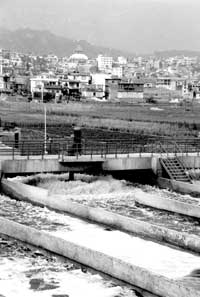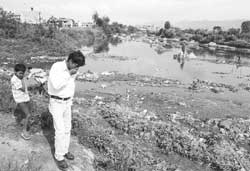 Bidur Prasad Poudel has a mammoth task on his hands. Nearly six years after being appointed president of the High-Powered Committee for the Implementation and Monitoring of the Bagmati Area Sewage Construction/ Rehabilitation Project, Poudel is still working hard to reinvigorate the river that runs through the Valley. ("A sewer runs through it," #39)
Bidur Prasad Poudel has a mammoth task on his hands. Nearly six years after being appointed president of the High-Powered Committee for the Implementation and Monitoring of the Bagmati Area Sewage Construction/ Rehabilitation Project, Poudel is still working hard to reinvigorate the river that runs through the Valley. ("A sewer runs through it," #39) But he, and every capital resident who's ever been felled by the odours in the air or the sewage flowing through their taps can take heart. His work is starting to pay off. The waters of the Bagmati, the river that originates in the Shivapuri hills and winds its way south across the Valley towards Chobar, has become relatively clean in the stretch from Gokarna to Tilganaga, just below Pashupati.
It's a development that hasn't gone unnoticed by people mourning their dead and taking ritual baths at the ghats of Pashupati. "It's been about six months, there has been clean water in the ghats," says Poudel. But, he acknowledges, there's still a long way to go-right up to Chobar. The Rehabilitation Project's first and second phase, cleaning up the river from Gokarna to Tilganga, are complete.
Daily laboratory readings indicate that the pollution indicator, the biological oxygen demand (BOD) of the water, is at times even higher than the minimum acceptable standard. At the inlet it is 300 mg per litre, but after it is treated, it is 22 mg - 40 mg per litre at the outlet-meaning that one can bathe and wash in the water. The project even supplies drinking water to the Pashupati area.
With a population that has surpassed 1.7 million, the Valley now generates 750 cubic metres of solid waste every year. About 70 percent of this is disposed by the municipality in various landfills, and 5-10 percent is recycled. But the rest is dumped on the banks of the river. The Bagmati is not just a sewer, but also a garbage dump.
The project initially acquired just over 4.5 hectares of land in Guhyesowri, just north of Pashupati, to set up a sewage separation and water treatment plant, and also 25 hectares of private land along the river to build roads, a 20 metre greenbelt, and embankments. The plant at Kumarigal, Guhyeswori, separates sewage entering the river from the Mitra Park and Gokarna areas and filters the water before releasing it into the river beyond Pashupati via an underground tunnel. Sludge, or sediment from the treated water, is pumped into drying beds, and the project hopes to sell or distribute it to the public as fertiliser.
 So far, an estimated Rs 500 million has been spent on the project. "By the time we finish with this portion, it will cost a little over Rs 600 million," says project manager Ram Deep Shah. An initial survey by the committee indicates that cleaning the river up all the way to Chobar will cost Rs 7 billion. "Speaking from experience, if all goes well in terms of funding and logistics, we can clean up the river all that way in two-and-a-half or three years," says Poudel. "But at the present rate of progress, it could take twenty years."
So far, an estimated Rs 500 million has been spent on the project. "By the time we finish with this portion, it will cost a little over Rs 600 million," says project manager Ram Deep Shah. An initial survey by the committee indicates that cleaning the river up all the way to Chobar will cost Rs 7 billion. "Speaking from experience, if all goes well in terms of funding and logistics, we can clean up the river all that way in two-and-a-half or three years," says Poudel. "But at the present rate of progress, it could take twenty years." They are already experiencing some hitches. The foam that rises from the treatment plant every morning is an indication of chemical pollutants from the 68 industries-garments, carpets, dyeing, and small handicrafts-upstream. "Chemical pollutants slow down the water treatment process. It slows down the growth of bacteria that help clean the water." Numerous letters have been despatched to the Ministry of Industry, Commerce and Supplies to monitor the use of chemicals. "But they are not reacting as quickly as we would like them to," explains Poudel.
The term of the committee runs for just another three months, but members have recommended to the prime minister and the Ministry of Housing and Physical Planning to extend their term or set up another committee that will focus on cleaning up all the rivers in the Valley-the Bishnumati, Manohara, Tukuche, Hanumante, Dhobi Khola-and not just the Bagmati. "After coming so far, I don't think it's impossible," smiles Poudel, whose team has to work with the concerned VDCs, DDCs, the Kathmandu Metropolitan City, as well as the concerned ministries and the public. "If the government and the public want it to happen and everyone works towards that goal, it's not impossible." But he also calls on civil society to help, to ensure that things go as planned. "If people like the Chaudhary Group, who have already expressed much concern about the state of the Bagmati, offer to clean up the area below Tilganga until Thapathali, I'd support them all the way."


